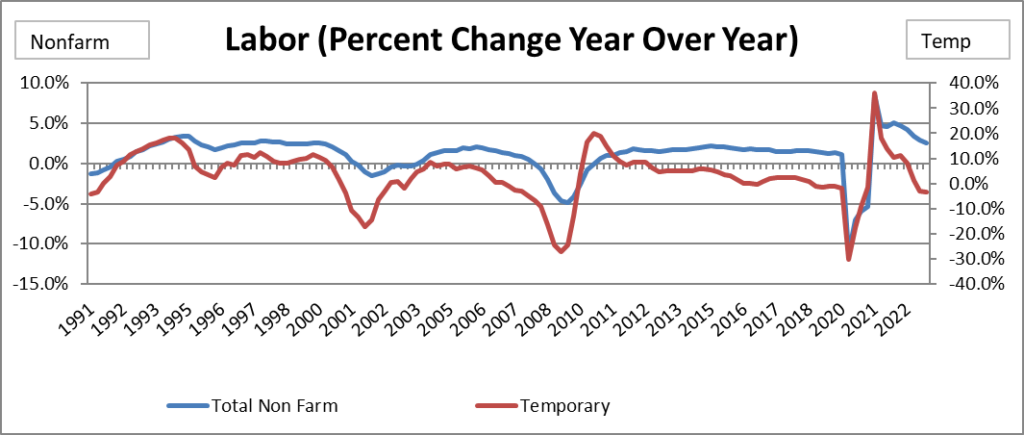Labor Forecast Predicts 4.3% Decrease in Demand for Temporary Workers in 2023 Third Quarter
– Industry Consulting Firm G. Palmer & Associates’ Quarterly Forecast Assists in Previewing Near-Term Hiring Pattern –
Newport Beach, California, August 4, 2023 — Demand for temporary workers in the United States is expected to decrease 4.3% on a seasonally adjusted basis for the 2023 third quarter, when compared with the same period in 2022, according to the Palmer Forecast™, released today. Demand has been softening since the fourth quarter of 2022.
The Palmer Forecast™ indicated a 2.0% decrease in temporary help for the 2023 second quarter. Actual results as reported by the Bureau of Labor Statistics (BLS) were slightly worse, with a decrease of 3.3%.
A total of 9.6 million open jobs were reported by the BLS as of the end of June 2023. However, non-farm payroll growth has seen a steady softening throughout the second half of 2022, and this trend is continuing into 2023.
Source: G. Palmer & Associates; Bureau of Labor Statistics (BLS)
Source: Bureau of Labor Statistics (BLS)
The BLS reported that temp help jobs decreased by 12,600 in June 2023, a loss of 3.4% year-over-year, and down 26,400 jobs year to date, or an average of 4,400 temp job lost per month. According to the BLS, there was a decline of 30,000 temp jobs in 2022, or an average of 2,500 temp jobs lost per month. Temp jobs growth in 2021 was strong, with a total gain of 302,000 jobs, compared with the prior two years, when 201,000 temp jobs were lost in 2020, and 27,000 temp jobs were lost in 2019. In 2018, more than 99,000 temp help jobs were added over 2017.
The Labor Department reported that non-farm payroll employment increased by 209,000 jobs in June 2023, which missed consensus estimated increases of 225,000 jobs. For the 2023 second quarter, there were 244,000 non-farm jobs added per month. Growth for the 2023 second quarter indicates a softening in the labor market, especially when considering that 73,000 jobs were created in education and healthcare. For the 2022 full year, there were 4.5 million jobs added, an average of 375,000 jobs per month. In 2021, non-farm employment was up by 6.4 million jobs, compared with 2020. To put this in perspective, there were 9.4 million jobs lost in 2020, and 2.1 million total jobs added for 2019. For 2018, a total of 2.6 million new jobs were created, versus 2.1 million new jobs in 2017.
The key categories of jobs created are as follows:
- Total Non-Farm: +205,000
- Private Sector: +149,000
- Private service producing: +120,000
- Government: +60,000
- Healthcare: +41,000
- Social Assistance: +24,000
- Hospitality: +21,000
- Professional and Business Services: +21,000
- Temp Help: -12,600
- Retail Trade: -11,000
- Construction: –10,000
- Transportation and Warehousing: -7,000
Source: Bureau of Labor Statistics (BLS)
In June 2023, the labor participation rate was unchanged from May 2023, at 62.6%, and it has been in a narrow range of 64.4% to 61.9% since June of 2020. The U3, commonly referred to as the unemployment rate, decreased 10 bps to 3.6% in June versus May.
As reported by the BLS, the rate of unemployment for workers with college degrees in June 2023 was the same as May 2023, at 2.0%. The unemployment rate for workers with less than a high school education increased 30 bps to 6.0%. The U6 unemployment rate, which tracks those who are unemployed, as well as those who are underemployed and are working part-time for economic reasons, was down 20 bps to 6.9% in June versus May. The U6 rate is considered the rate that most broadly depicts those most affected by the last economic downturn and measures the rate of discouraged workers.
“The temp help employment market is showing further signs of slowing down. Until GDP growth resumes to a stronger level and interest rates stabilize, growth will be nonexistent, and temp help will continue to soften,” said Greg Palmer, founder and managing director of G. Palmer & Associates, an Orange County, California-based human capital advisory firm that specializes in workforce solutions. “A further indicator to watch is the temp help penetration rate, because it measures temp help as a percentage of total employment. In June 2023, the temp help penetration rate decreased slightly to 1.93% of the total labor market, compared with an all-time high of 2.08%, achieved in February 2022, and a pre-pandemic level of 1.57%, a further sign of temporary jobs lessening.
“The penetration cycle last peaked at 2.05% in December 2015, and it was at a low of 1.3% in June 2009. The American Staffing Association (ASA) Staffing Index moving average closed down slightly, at a value of 99, on July 23, 2023, which was 6.1% lower than the same period last year,” Palmer added.
Source: Bureau of Labor Statistics (BLS)
About the Palmer Forecast™
The Palmer Forecast™ is based, in part, on BLS and other key indicators. The model was initially developed by the A. Gary Anderson Center for Economic Research at Chapman University and serves as an indicator of economic activity. Companies that employ temporary staff use the forecast as a guide to navigate through fluctuating economic conditions in managing their workforce to meet business demands.
About G. Palmer & Associates
- Palmer & Associates, founded in 2006, provides advisory services in the human capital sector. FounderGreg Palmer has served on the board of the American Staffing Association and was president and chief executive officer of RemedyTemp, Inc., one of the nation’s largest temporary staffing companies, prior to its sale in June 2006. For more information, visitwww.GPalmerandAssociates.com.
# # #














